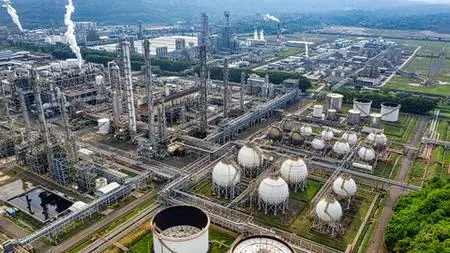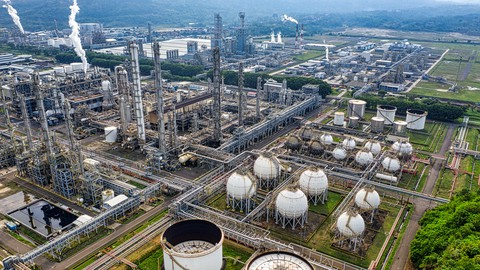Process Equipment Essentials For A Successful Career Start
Published 11/2022
MP4 | Video: h264, 1280x720 | Audio: AAC, 44.1 KHz
Language: English | Size: 3.19 GB | Duration: 6h 21m
Published 11/2022
MP4 | Video: h264, 1280x720 | Audio: AAC, 44.1 KHz
Language: English | Size: 3.19 GB | Duration: 6h 21m
Overview of pipe valves vessels tanks heat exchangers pumps compressors distillation steam traps strainers and much more
What you'll learn
Understand how the various types of valves work (gate, globe, plug, ball, diaphragm…)
Understand the main components of control valves and how they work
Understand the concept of failure mode in control valves : Fail Open "FO", Fail Closed "FC", Fail As Is "FAI"
Understand the concept of "Air-to-push-up" and Air-to-push-down" in control valves
Understand how the various valve actuators work
Understand how safety and pressure relief valves work
Understand how steam traps work and why they are essentials in steam systems (Floating, Thermostatic, Thermodynamic and Inverted Bucket traps)
Understand how strainers work (Wye and Basket strainers)
Understand how the various heat exchanger types work (shell and tube, double pipe, plate and frame, kettle reboiler…)
Know, understand and interpret TEMA standards and terminologies for shell and tube heat exchangers
Understand how cooling towers work and their major components
Understand how fired heaters and furnaces work
Understand how distilling columns work
Understand how centrifugal pumps work
Understand how positive displacement rotary pumps work (gear, lobe, vane, screw…)
Understand how positive displacement reciprocating pumps work (plunger, diaphragm, piston…)
Understand how dynamic compressors work (axial and centrifugal)
Understand how positive displacement rotary compressors work (lobe, vane, screw…)
Understand how positive displacement reciprocating compressors work (plunger, diaphragm, piston…)
Understand how flare systems work and their safety rationale
Test your knowledge with 200+ question quiz
Requirements
No prerequisites required. We promise you that the various video lectures can be watched easily, without pain, but with comprehension.
Description
The general knowledge as to how process equipment really functions is disappearing from the process industries. This is not only our opinion but the general view of senior technical managers in many large corporations.Chemical process equipment is basically the same now as it was in the 1930s.The distilling columns, KO drums, compressors, pumps, heat exchangers, valves, steam systems have not changed, and probably will not change.The fundamental nature of process equipment operation has been well established for a very long time.The chemical engineer has traditionally been the guardian of process knowledge. So, one would suppose that if fundamental process knowledge is vanishing, the origin of the problem may lie in our universities.But in this online course, we have gone back to the very simplest basis for understanding process equipment. In every section and video lecture we have said: “Here is how the equipment behaves in the field, and this is why.”The guiding idea of our course is that it is better to have a working knowledge of a few simple ideas than a superficial knowledge of many complex theoretical subjects.In this course, you will find valuable insights into the working principles and construction details of the following process equipment:Piping systemsValvesControl valvesActuatorsSafety and pressure relief valvesSteam trapsStrainersHeat exchangersFired heatersCentrifugal pumpsPositive displacement pumps (rotary and reciprocating)Dynamic compressors (axial and centrifugal)Positive displacement compressors (rotary and reciprocating)Distilling columnsTanks and vesselsFlare systemsThe course includes:extensive graphicscross-sectional views3D animationsThis will give you a virtual practical exposure on process equipment.In addition, we have included at the end of the course a technical quiz (200+ questions) to help you test your knowledge and emphasize the key learning points.The quiz includes:True/False questionsMulti-choice questionsImages, cross-sectional viewsSolved problemsand much more…So when you think you’ve got a good grasp on a topic within the course, you can test your knowledge by taking the quiz. If you pass, wonderful ! If not, you can review the videos and notes again or ask us for help in the Q&A section.Lastly, we hope and believe that this valuable course will help you do a better job and will help you contribute to the safety of your facility, your fellow workers and yourself.We promise you that even though this is a technical training, you can watch it easily, without pain, but with comprehension, and that after completing it, you won't be an experienced operator or process engineer but you will be prepared to become one if that is what you like and persist to be.Thank you again for your interest in our online courses. It is a privilege to serve you and make sure that you're learning valuable information with us.WR TrainingSpread the wings of your knowledge
Overview
Section 1: About the course
Lecture 1 Before you start
Section 2: Piping
Lecture 2 Pipe materials
Lecture 3 Manufacturing methods
Lecture 4 Sizing of pipe
Lecture 5 Wall thickness
Lecture 6 Pipe selection
Lecture 7 Methods of joining pipe
Lecture 8 Cast iron pipe
Lecture 9 More on the schedule system
Lecture 10 Joining cast iron pipe
Lecture 11 Plastic pipe
Lecture 12 Joining plastic pipe
Section 3: Valves
Lecture 13 Valves learning objectives
Lecture 14 Introduction
Lecture 15 Valve body
Lecture 16 Valve bonnet
Lecture 17 Valve trim
Lecture 18 Disc and seat
Lecture 19 Stem
Lecture 20 Valve actuator
Lecture 21 Valve packing
Lecture 22 Learning objectives of the next valve lectures
Lecture 23 Numerous sizes, styles and pound ratings
Lecture 24 Gate valves
Lecture 25 Globe valves
Lecture 26 Ball valves
Lecture 27 Plug valves
Lecture 28 Pinch valves
Lecture 29 Diaphragm valves
Lecture 30 Butterfly valves
Lecture 31 Needle valves
Lecture 32 Check valves
Lecture 33 Swing check valves
Lecture 34 Tilting disk check valves
Lecture 35 Lift check valves
Lecture 36 Piston check valves
Lecture 37 Butterfly check valves
Lecture 38 Stop check valves
Lecture 39 Two port valves
Lecture 40 Three port valves
Section 4: Safety and pressure relief valves
Lecture 41 Overview
Lecture 42 Safety valves
Lecture 43 Relief valves
Lecture 44 Valve operation in 2D cross-sectional view
Lecture 45 Valve operation in 3D
Section 5: Control valves
Lecture 46 Overview
Lecture 47 Direction of action and failure mode
Section 6: Actuators
Lecture 48 Manual handwheels
Lecture 49 Electric motor actuators
Lecture 50 Pneumatic actuators
Lecture 51 Pneumatic actuators Single acting spring return #1
Lecture 52 Pneumatic actuators Single acting spring return #2
Lecture 53 Pneumatic actuators Double acting #3
Lecture 54 Pneumatic actuators Double acting #4
Lecture 55 Pneumatic actuators From Single Acting to Double Acting
Lecture 56 Scotch Yoke from Fail Closed (FC) to Fail Open (FO)
Lecture 57 Rack and pinion from Fail Closed (FC) to Fail Open (FO)
Lecture 58 Scotch Yoke vs Rack and pinion
Lecture 59 Hydraulic actuators
Lecture 60 Position indication
Section 7: Steam traps
Lecture 61 Overview of steam traps
Lecture 62 Floating traps
Lecture 63 Thermostatic traps
Lecture 64 Thermodynamic traps
Lecture 65 Inverted bucket traps
Section 8: Strainers
Lecture 66 Overview
Lecture 67 Wye strainers
Lecture 68 Basket strainers
Section 9: Guidelines for valves and actuators
Lecture 69 What type of valves should be installed ?
Lecture 70 Sharing guidelines and best practices for valves and steam lines
Section 10: Heat exchangers
Lecture 71 Introduction
Lecture 72 Overview
Lecture 73 Shell & Tube #1
Lecture 74 Shell & Tube #2 3D animation
Lecture 75 TEMA types
Lecture 76 Fixed tubesheet BEM exchanger
Lecture 77 CFU exchanger
Lecture 78 Floating tubesheet exchanger
Lecture 79 AEP exchanger
Lecture 80 AJW exchanger
Lecture 81 AES exchanger
Lecture 82 Plate and Frame
Lecture 83 Spiral plate
Lecture 84 Plate and fin
Lecture 85 Spiral tubes
Lecture 86 Jacketed vessels
Lecture 87 Double pipe
Lecture 88 Reboilers
Lecture 89 Air coolers
Lecture 90 Air coolers : Forced vs Induced
Lecture 91 Air fans
Section 11: Cooling towers
Lecture 92 Cooling towers
Section 12: Fired heaters and furnaces
Lecture 93 Introduction
Lecture 94 Functions
Lecture 95 Description of fired heaters
Lecture 96 Different types
Lecture 97 Vertical cylindrical furnaces
Lecture 98 Radiant wall furnaces
Lecture 99 Box type furnaces
Lecture 100 Cabin furnaces
Lecture 101 Double fired furnaces
Lecture 102 Summary
Section 13: Accessories
Lecture 103 Ladders, Cages & Platforms
Section 14: Distilling columns
Lecture 104 What is distillation
Lecture 105 Limits of distillation
Lecture 106 Types of distillation
Lecture 107 Concept of volatility
Lecture 108 Distillation practices
Lecture 109 Distillation explained using 3D animation
Lecture 110 Liquid vapor contact
Section 15: Pumps
Lecture 111 Centrifugal pumps - Overview
Lecture 112 Centrifugal pumps - Nozzle arrangement
Lecture 113 Centrifugal pumps - Drivers
Lecture 114 Positive displacement pumps overview
Lecture 115 Positive displacement - Classification
Lecture 116 Positive displacement - Rotary - Gear pumps
Lecture 117 Positive displacement - Rotary - Lobe pumps
Lecture 118 Positive displacement - Rotary - Vane pumps
Lecture 119 Positive displacement - Rotary - Screw pumps
Lecture 120 Positive displacement - Reciprocating - Plunger pumps
Lecture 121 Positive displacement - Reciprocating - Diaphragm pumps
Section 16: Compressors
Lecture 122 Overview
Lecture 123 Types and applications
Lecture 124 Positive displacement compressors - Rotary lobe
Lecture 125 Positive displacement compressors - Rotary vanes
Lecture 126 Positive displacement compressors - Rotary screw
Lecture 127 Positive displacement compressors - Reciprocating
Lecture 128 Dynamic compressors - Centrifugal single stage
Lecture 129 Dynamic compressors - Centrifugal multi-stage
Lecture 130 Dynamic compressors - Axial
Section 17: Flare systems
Lecture 131 Do we need to flare at all
Lecture 132 Types of flares
Lecture 133 Flare system components
Lecture 134 Why it is hazardous to burn liquids in a flare system
Section 18: Tanks and vessels
Lecture 135 Horizontal vessels
Lecture 136 Vertical vessels
Lecture 137 Storage tanks
Section 19: Course Quiz
Freshly graduated engineers (mechanical, process and chemical),Newly hired plant operators



